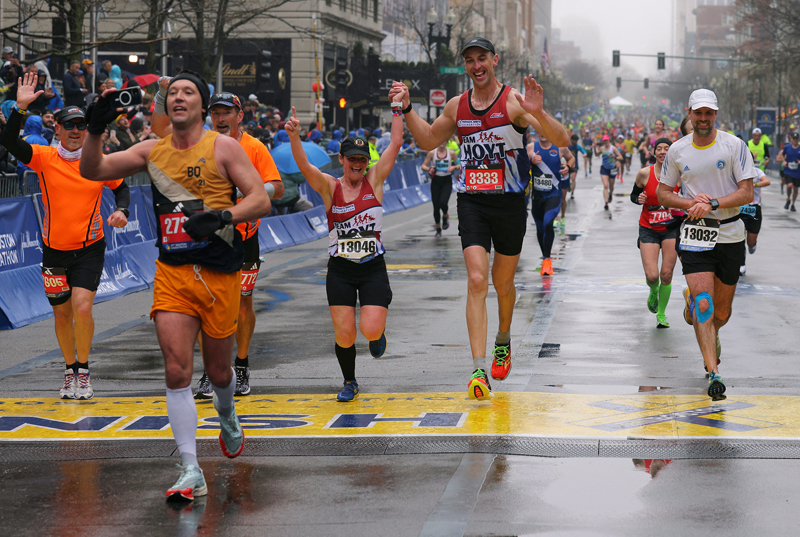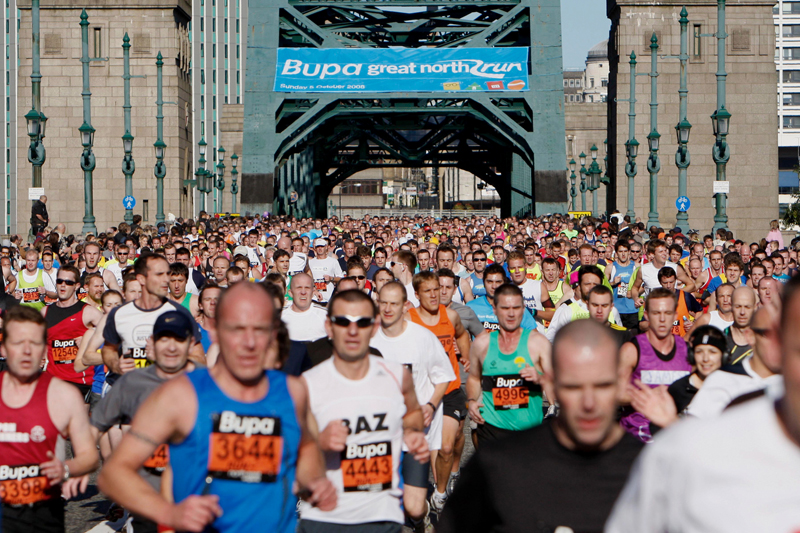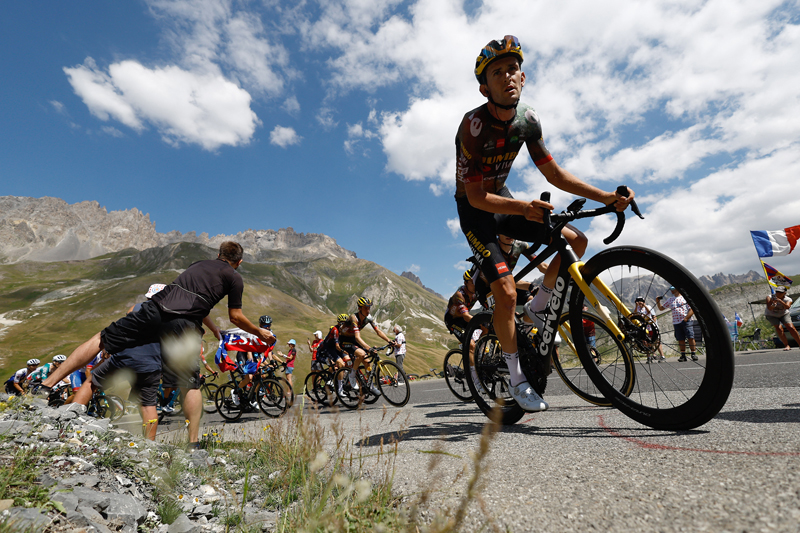Lactate threshold: 2-2 t-20
Since I first started attaching a fairly specific intensity to lactate-threshold workouts about 10 years ago, the whole idea of threshold training seems to have gained in popularity
'Tempo runs' and 'cruise intervals' are two types of workouts that fit the threshold description, because both are run at about lactate-threshold pace. Tempo runs have actually been around for a long time; I merely pinned down an intensity of effort which can be attached to the name, so that runners of all abilities and levels would know how fast to run during their threshold workouts. As I've pointed out many times, threshold pace is usually about 10-15 seconds per mile slower than current lOK race velocity.
About the same time that I was beginning to understand the merits of tempo runs, which can also be called steady-threshold efforts, Bertil Sjodin, an outstanding Swedish exercise scientist and coach, told me about the benefits of 'broken-threshold' training. Unlike the continuous tempo runs with which I was familiar, Sjodin's broken-threshold sessions fitted abbreviated recovery periods into the overall workout. The advantage of the recoveries was that they permitted more total running at threshold pace per workout; by getting brief breaks, runners felt that they could continue working longer. The disadvantage was that the recoveries made the overall workout much less like a real race effort. To put it another way, some specificity was lost.
However, I was intrigued by the possibility of giving runners a chance to get in more threshold work per workout, and I borrowed the term 'cruise intervals' from swimming coaches and attached it to Sjodin's broken-threshold sessions. Since then, I've further described cruise intervals as being a series of individual exertions which vary in length from three to 10 minutes each and which are conducted at threshold intensity, with very brief recovery periods (usually one minute, or even less) between work bouts. Based on the number of letters and telephone calls which I receive, it's clear that both tempo runs and cruise intervals are much more popular than they were a decade ago. Tempo runs and cruise intervals seem to provide an ideal training intensity for runners of all proficiencies and ages.
However, threshold training is not without problems. If you are running your 10Ks at about 6:45 per mile, for example, it's true that your threshold probably rests in the 6:55-7:00 per mile zone, but what if your 10K courses are usually flat and you like to do your threshold runs over hilly terrain, or vice versa? Running at 6:45 pace during a very hilly 10K and then pegging your threshold pace at 6:55-7:00 on a flat track would make your threshold workout too easy, for example. The same problem arises when you try to factor in head winds, tail winds, variations in running surface, temperature differences and even changes in running clothing. Obviously, using pace per mile as an intensity guide can often lead to problems in zeroing in on threshold intensity during workouts.
Should you use heart rate?
One increasingly popular solution to this problem is to rely on heart rate, not running pace, to reckon threshold intensity. It's worth noting that running at threshold intensity (which is about 80-88 per cent of current V02max) usually produces a heart rate of about 85-92 per cent of maximum. Attaching this range of heart rates to threshold intensity means that threshold training can then be carried out under a wide variety of different environmental conditions. You no longer have to worry about your actual pace; all you have to do is make sure that your exercise heart rate is in the threshold zone. Another advantage is that the intensity of non-running workouts like cycling and swimming can also be planned using heart rate as a guide. If you want to work out on an exercise bike at threshold intensity, it' s fairly easy. You don't have to worry too much about watts, calories per minute or rpms; you just have to get your heart rate inside the threshold range. However, you should know your maximal heart rate on the bike, which is usually lower than max heart rate while running.
However, as you no doubt know, there are also problems associated with using heart rate to find threshold intensity. My key concern about using heart rate monitors is that you must know your true maximum heart rate in order to link a specific heart rate with your threshold intensity. For example, if you use the '220 minus age' formula to determine maximum heart rate and your age is 40, this predicts a max heart rate of 180. But what if your true max is 170? I have tested men in their forties who have maximum heart rates as low as 150 or as high as 190-200. 90 per cent of the predicted max heart rate of 180 would put threshold heart rate at 162. If your true max heart rate is in the 150-160 range, you'll run far too fast during threshold workouts in an attempt to get your heart rate up to what you believe is threshold intensity. On the other hand, if your true max heart rate is 190-200, a running speed that produces a heart rate of 162 will be too slow to represent true threshold intensity.
The other problem is that 85-92 per cent of maximum heart rate is just an average: not all runners have their thresholds within this heart-rate zone. Some elite runners probably have thresholds in the 92-95 per cent range, while many other runners have a threshold at about 80 per cent of max heart rate or even lower. If your true threshold is at 75 per cent and you try to reach 85 per cent during a tempo run, your workout will be so hard that you will have to cut it short, which can be very discouraging. In addition, even if you were sure that your threshold were somewhere between 85 and 90 per cent of maximum, there's a considerable amount of 'play' there. If your max heart rate is 200, 85 per cent of max is 170 and 90 per cent is 180. What should be the better training heart rate - 170 or 180? Should you split the difference and use 175, or simply oscillate back and forth between 170 and 180? The answer isn't clear. Also, it's important to point out that heart rate can vary a fair amount from day to day, due to changes in mood, hormone levels, state of hydration and even the severity of one's training in the past week or so.
Since pace only predicts threshold under unvarying conditions and there are many problems with using heart rate to judge threshold intensity, is there any other way to estimate lactate threshold during your tempo runs and cruise intervals? My experience tells me that there is in fact an excellent alternative: runners can actually use their breathing rates to gauge their thresholds.
Your breathing pattern at threshold
Most runners breathe in a very rhythmic fashion, taking a certain number of steps while inhaling and a fixed number of steps while exhaling. As mentioned, the most popular breathing patterns are the 2-2 and 3-3 ('2-2' simply means that you take two footfalls - right and left - while breathing in and two steps while breathing out). 2-1 and 1-2 are other popular breathing techniques, but they are reserved for very hard efforts. Occasionally you may even hear runners using a 1-1 scheme near the end of a race, which I like to call 'freight-train' breathing.
For most runners, 3-3 breathing can be used during easy to moderate runs, while the 2-2 rhythm corresponds pretty well with threshold running. If you're forced to crank your breathing up a notch or two to 2-1 or 1-2 it does mean that you are working very hard, in fact too hard for threshold running, which I call a 'comfortably hard' effort. Threshold running should be fairly hard, but at the same time comfortable enough to be able to sustain for 20 minutes or so.
For that reason, I call threshold work '2-2 T-20 training' which stands for 2-2 breathing rhythm during a threshold run lasting 20 minutes. Some of my runners just call it a 2-2 tempo run. As soon as you have to break away from 2-2 breathing and move to 2-1 or 1-2, you know you are operating at too high an intensity to be at your threshold pace, so you must slow down until 2-2 feels comfortable again.
Just as a heart monitor tells you to slow down on uphills in order to maintain a constant heart rate, your breathing rhythm also lets you know if you are trying to maintain too fast a pace as you climb hills or head into the wind. The same principle applies at altitude. A slower running pace is associated with a 2-2 breathing pattern at altitude compared to sea-level, but that's OK if you want to carry out threshold training the right way. At high elevations, the lower oxygen pressures produce a desire to ventilate harder at your typical running speeds. However, since V02max is lower at altitude, 80-88 per cent of V02max (threshold intensity) will correspond with a slower pace at altitude; using a 2-2 breathing pattern will help you maintain this slower pace.
I haven't said much about the 'odd' breathing rhythms of 2-3 and 3-2, both of which are sometimes acceptable for threshold running, although they're not very common. If one of these rhythms suits you well, then by all means use it. You're simply one of the rare 2-3 T-20 runners instead of a 2-2. One way to establish what kind of a threshold runner you are is to plan a threshold workout by pace in ideal conditions. Your recent lOK should have been fairly flat and windless, for example, and your workout would be under the same conditions, but at a pace which is 10-15 seconds per mile slower. The natural breathing rate you use during this session will be your threshold breathing rhythm. It will probably be 2-2 but, as I've said, it might be 2-3 or 3-2.
However, you must be cautious about using breathing pattern for monitoring your intensity during cruise intervals. The shorter the work bout that you choose (cruise intervals can be as short as three minutes), the less likely it is that breathing pattern will be firmly established before the end of the first or even second work interval. When cruise intervals are kept short, you may often end up running faster than threshold pace; during a tempo run a shift to a higher breathing rate would warn you that you're going too fast, but during short cruise intervals you might never make that breathing adjustment, since you get a recovery break every three or four minutes or so. For that reason, 2-3 or 3-2 patterns often work best for cruise intervals, even though 2-2 may be ideal for a tempo run.
Many runners ask: if 2-2 is linked with threshold intensity and lOK races are run at above-thresh old intensity, isn't it best to use 2-1 or 1-2 right from the beginning of a lOK? That makes sense, but bear in mind that you can use 2-2 with a variety of depths of breathing. A good runner who employs 2-2 will start using that rate immediately at the beginning of a lOK race, thus falling into a nice rhythm right from the start. As the race goes on, the rate will typically remain the same for a while but each breath may get deeper. Eventually, with enough fatigue and discomfort, a break in rhythm will be necessary, and a 2-1 or a 1-2 will take over.
Always remember that the key ingredient in proper threshold training is to use the proper intensity of effort, not necessarily the particular pace or heart rate. It's true that running speed and heart rate sometimes work well as threshold-intensity markers but it's also possible to use your rate of breathing to find threshold intensity during workouts. Having the ability to do this has worked very well for many of my most successful runners because they become very good judges of intensity during races. To put it simply, they can use their breathing patterns to figure out what they can handle during during a race and how long they can cope with various intensities, while their opponents are often groping in the dark. Once you know what breathing pattern corresponds with threshold intensity, you develop a certain mental confidence and you always know how hard you are working, regardless of whether you're running on a track on a perfect day, climbing steep hills into impossible head winds or slogging through the muck of a cross-country course. As a result, you'll sustain a much more consistent, efficient effort during your workouts and, most important, you'll maintain your highest-possible pace during races.
You need to be logged in to continue reading.
Please register for limited access or take a 30-day risk-free trial of Sports Performance Bulletin to experience the full benefits of a subscription. TAKE A RISK-FREE TRIAL
TAKE A RISK-FREE TRIAL
Newsletter Sign Up
Testimonials
Dr. Alexandra Fandetti-Robin, Back & Body Chiropractic
Elspeth Cowell MSCh DpodM SRCh HCPC reg
William Hunter, Nuffield Health
Newsletter Sign Up
Coaches Testimonials
Dr. Alexandra Fandetti-Robin, Back & Body Chiropractic
Elspeth Cowell MSCh DpodM SRCh HCPC reg
William Hunter, Nuffield Health
Keep up with latest sports science research and apply it to maximize performance
Today you have the chance to join a group of athletes, and sports coaches/trainers who all have something special in common...
They use the latest research to improve performance for themselves and their clients - both athletes and sports teams - with help from global specialists in the fields of sports science, sports medicine and sports psychology.
They do this by reading Sports Performance Bulletin, an easy-to-digest but serious-minded journal dedicated to high performance sports. SPB offers a wealth of information and insight into the latest research, in an easily-accessible and understood format, along with a wealth of practical recommendations.
*includes 3 coaching manuals
Get Inspired
All the latest techniques and approaches
Sports Performance Bulletin helps dedicated endurance athletes improve their performance. Sense-checking the latest sports science research, and sourcing evidence and case studies to support findings, Sports Performance Bulletin turns proven insights into easily digestible practical advice. Supporting athletes, coaches and professionals who wish to ensure their guidance and programmes are kept right up to date and based on credible science.









